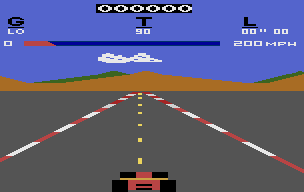 |
| Pole Position on the Atari 2600 |
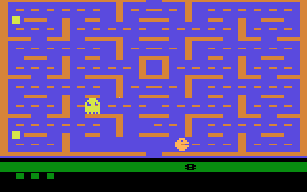 |
| Pac-Man™ on the Atari 2600 |
I was introduced to computer games by my best friend around age 10. Back then, games consoles were connected to the (parents') TV set; games had to be purchased as ROM cartridges, and most games allowed single or double player gameplay via joysticks. Of course, it wasn't enough that my friend possessed one; I wanted to have one, too. Thus, 1987's Xmas wish list consisted of an Atari 2600 (the same model that my friend had), a game console that was first released 10 years earlier, and was thus available in department stores for an affordable price (about DM 100, if I remember correctly). Game cartridges cost between DM 15 - 35, and couldn't be copied, so one had to swap cartridges with friends and classmates, and young pupils weren't yet nurtured in an environment of profligate software pirating.
Anyway, after owning about 7 different games, I had so many ideas, and wanted to start writing games. I knew that this wasn't possible on my console, that I needed a "real" computer. And so in May-1988, aged 12, I started investigating the available home computers. Fortunately, the 64'er computer magazine just ran a cover story comparing the leading home computers Commodore 64 / 128, Amiga 1000, Atari 800XE, Atari 520ST, Schneider CPC 464 against an IBM-compatible XT.
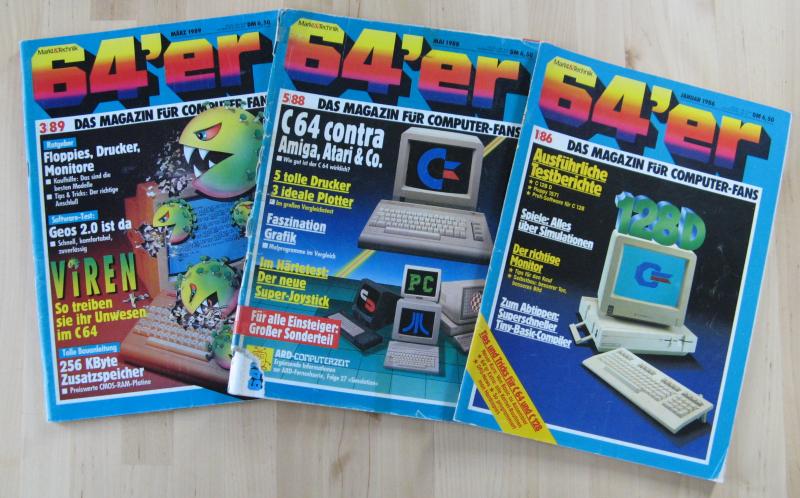
This magazine contained many pages of machine code and BASIC programs meant to be typed into the computer; though one could buy a 5¼" floppy disk containing all the software, at DM 29.90 (vs. DM 6.50 for the magazine, and my usual monthly allowance of DM 20) is was way too expensive.
20 years later, we're living with multi-megabit Internet connections, and software updates alone can be several megabytes large. Back then, software updates didn't exist; occasionally, the magazine would publish a correction a la In last issue's foo program, at address 0x3460 replace 7f fe ab 80 with 7e ff ac 88
.
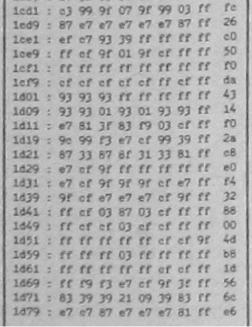 |
 |
| machine code listing… | …spanning many pages |
All of that strange new world didn't frighten me; in fact, I decided that the Commodore 64 would be the ideal computer for me, and started buying the magazine regularly. It was still half a year until next Xmas; so I had plenty of time to prepare and convince my parents. (I knew this would be difficult; a computer was quite expensive; so I planned to forgo a couple of future Xmas presents, in a sort of payment by installments scheme.)
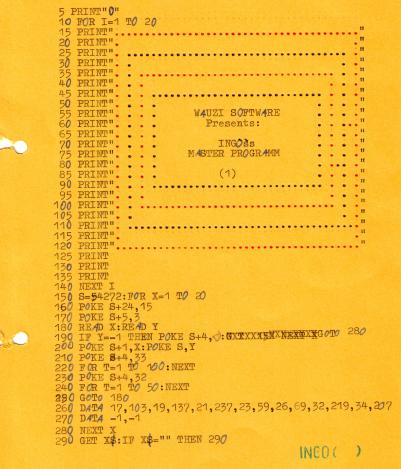 |
With my motivation to write my own computer games, the lack of a computer didn't prevent me from starting to teach myself programming. Each magazine contained many pages of source code written in BASIC. Plus, there were articles about the inner workings of the computer, and a tutorial on algorithms. I figured out pretty soon that the PRINT command creates output; my first program used that together with a FOR loop to create a scrolling intro animation followed by a sound effect, which I copied verbatim from an article without actually understanding it. I used my father's old typewriter (which had broken "A" and "O" letters, so I had to fill those in with a pen) to type it. For lack of real hardware, I could only execute it in my imagination, but that didn't stop me from dreaming about me developing interesting new games. My only chance of computer access was in the biweekly trip to the next town's department store with my parents. In the stationery section, there were some demonstration computers, right next to the calculators. I was always disappointed when they were turned off or occupied; but even when I was lucky, I only had a few minutes until my parents called me to move on.
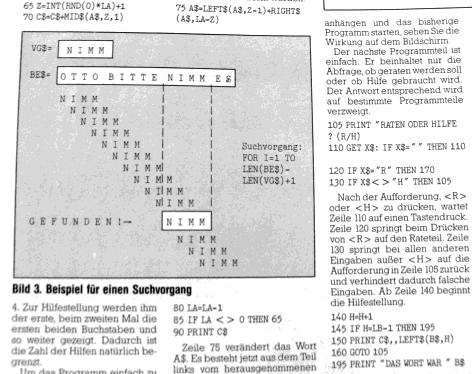 |
When I today read stories about young pupils in developing countries wanting to become software developers, I can relate to their fascination with technology. Thankfully, I had the privilege of parents who bought me a computer costing DM 1500 (about $1000 at the time; the typical "budget" for Christmas presents from parents and relatives was around DM 200). I initially proposed a more modest system (with datasette in place of floppy drive, and a monochrome monitor), but my mother persuaded me to chose the better alternative when I explained the pros and cons to her (my parents had no knowledge about computers at all, and no academic education): Well, but wouldn't a color monitor be nicer? … Well, but wouldn't a more powerful system allow you to do more things?
Thus, we finally settled for a Commodore C128D computer with a Commodore 1084 color monitor. With that impressive machine, I could both run the vast amount of C64 programs (well, mostly games) and had a powerful, professional system ideal for my programming endeavors.
Ingo Karkat, 15-Apr-2009